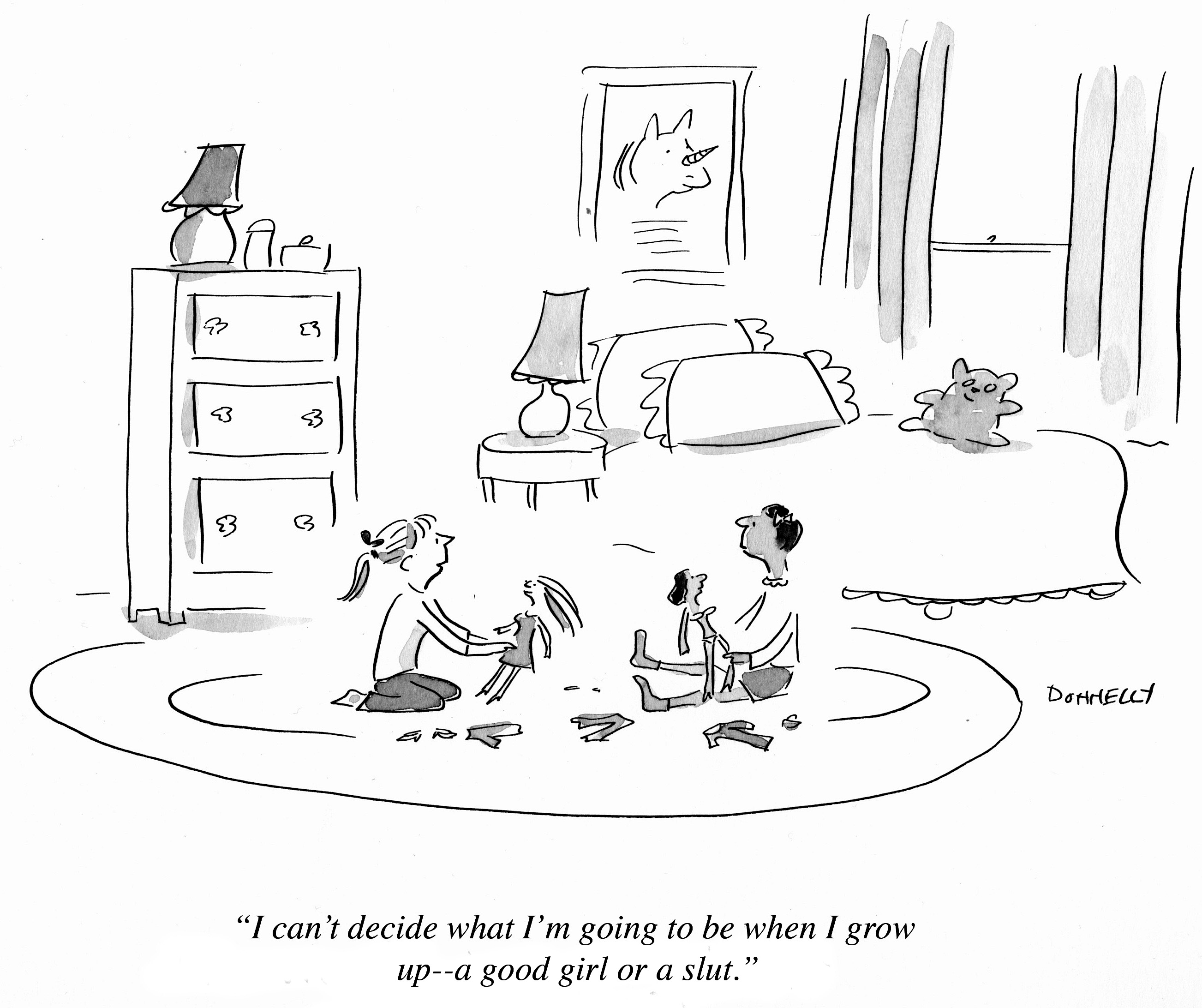When Liza Donnelly first began selling comics to The New Yorker Magazine in 1979, she was the youngest and one of only three cartoonists who were women. She has been lauded as a humorist who works not only to make the world a funnier place, but a better one. Liza speaks here with Women Of Green staff writer Sarah Skenazy about the politics of humor and the possibility for laughter to be a vehicle for social change.

A central theme in your cartoons is the ongoing and pervasive nature of gender roles and stereotypes. How do you use humor to address these issues?
Humor relies on what we already know. Generally speaking, it provides a mirror of the norms that we live with everyday and twists those norms to create the unexpected- that’s what elicits a laugh. You can use stereotypes that are well known in a society and play off them to either reinforce them or expose them. What I try to do is use my humor to critique assumed stereotypes and behaviors. This involves making fun of both men and women who perpetuate the standards.
Women are traditionally the standard bearers of cultural tradition. We have been the ones who pass it down from generation to generation; we know the rules well. Consequently, with our knowledge, we are perfectly positioned to know how to critique the rules with humor.
Why do you prefer not to address the issues overtly?
Because humor is something everyone loves (for the most part), it can be an effective way to get at these issues. In my type of cartooning, readers are not expecting to get a political point of view necessarily, so whatever I say in my cartoon reaches them sometimes unaware. Unlike a typical political cartoon, I am not necessarily expressing my opinion, but rather pointing out others’ absurd behavior, as depicted in my cartoon people. And it’s quick: the reader does not have to wade through an article on sexism, for example. I “get at” them before they know it!
You can look at cartoons throughout history and understand stereotypes by seeing what people laughed at in any given time period. It’s fascinating to do. It also requires taking into consideration where the cartoon appeared, and who the audience was. The New Yorker’s readership was and is very different from, say, The Daily News; so the cartoons in each publication will demonstrate not only what a particular demographic find funny, but what the owners of the publication think will sell issues.
The politics of published humor. That’s fascinating. Where does your inspiration come from for your New Yorker cartoons?
I get my inspiration from reading news outlets, both political and pop culture. I also rely on daily life! Twitter and FB are helpful, too.

Inherent in humor is the possibility for great thoughtfulness and subtlety. What makes a comic successful for you?
That is not easy to answer, because there are so many different types of comics, and they can be successful in different ways. I personally prefer to look at cartoons that are thoughtful and have meaning behind the joke. Cartoons that have several levels to them, and that are not just about a silly pun or easy joke—although I like those, too. When I read a cartoon that has depth, there’s the added element in that I appreciate how hard it is to do, and I like that. Good cartoons are a seamless blend of words and image.
Has humor been traditionally off limits to women?
Yes, but that is changing rapidly. There have been periods in our history when women were allowed into the humor business, but the periods were brief. Humor can be an aggressive medium, wherein the creator is controlling the audience. It is a form of control and dominance. Men didn’t want to give that to women, nor was it considered “feminine” to behave that way. Women were supposed to laugh at men’s jokes, not the other way around. I think they may have been afraid of the jokes we would tell about them (which we did amongst ourselves). On top of that, humor did, and still does, have an unwritten standard. This is one of the primary barriers to women now, I believe. What is considered “good humor” has traditionally been male, so if a woman created humor that was different, it was not considered funny. Or if they created humor about subjects from a woman’s perspective about topics of interest to women, it was considered not suitable humor material (I dislike the term “women’s issues” because all issues belong to all people. But there are areas that have traditionally been about and for women. However, it is not all we want to laugh about, of course).
Absolutely! Which female humorists do you think exemplify the break out from those restrictions?
Lily Tomlin and Whoopi Goldberg broke that in the 1970’s and 80’s by creating humor that was more nuanced and story-based, not just stand-up jokes. Many of the successful women in humor over the decades have simply used the male tradition well, and not forged their own voices like Tomlin and Goldberg. But there are a lot more women breaking the mold now, creating new types of humor. Tina Fey does both—she is trying to navigate traditional expectations of what is funny with her own voice.
Do you have any dreams of empowering more women and girls to leverage humor to their advantage?
I don’t know how to do that except by just talking about this subject. I also try to put women in my cartoons as often as possible, and try to make the woman the speaker in the cartoon. I want to rid the world forever of the notion that women don’t have a sense of humor, and that our humor is just as valid as anyone’s.
We need to let women and girls know that they can be funny, to acknowledge their power in making others laugh. It is indeed a powerful thing to do and they should not be afraid of it. I think we often are afraid of failure, so we don’t try. If someone doesn’t laugh at something you say or draw, don’t assume it’s because it’s not funny. Don’t assume it’s “your fault,” in other words. We as women can use our humor to help people see what it’s like to be a woman.
If women are the change agents, what is the change?
The change I would like to see is this: that everyone be treated equally, and be given the opportunity and freedom to be true to themselves.
Liza Donnelly is a contract cartoonist with The New Yorker Magazine. She is also a public speaker and presents on topics such as The New Yorker, cartoons, women and humor, and has spoken at TED and the United Nations among many other places. Her cartoons can be seen at: CNN.com; huffingtonpost.com; salon.com; dailybeast.com; womensEnews.org; narrativemagazine.com. Her work has also appeared in numerous publications, including The New York Times, Glamour, Cosmopolitan, The Nation and The Harvard Business Review, and her cartoons have been exhibited around the world.
Her new book, When Do They Serve The Wine? The Folly, Flexibility and Fun of Being a Woman, was published in 2010 by Chronicle Books. She is a charter member of an international project, Cartooning for Peace, helping to promote understanding around the world through humor. Recently, Liza received an International Award in France at the Salon International du Dessins de Presse for her work in cartooning.
Her website is lizadonnelly.com and her blog is whendotheyservethewine.com. You can also find her on Facebook. Donnelly teaches part-time at Vassar College. and is a member of PEN, Authors Guild and the National Cartoonist Society. She and her husband, New Yorker cartoonist, Michael Maslin, live in New York.
